Landfill gas (LFG) monitoring procedures involve routine, site-specific procedures to detect gas leaks and ensure operational compliance, including monitoring methane, carbon dioxide, and other trace gases using portable instruments and fixed systems.
Read on for our explanation of good practice procedures that include wellhead monitoring for oxygen, nitrogen, and carbon monoxide, perimeter monitoring for ambient emissions, and building monitoring at restored sites to prevent gas intrusion. The local environmental regulator usually requires licensed (“permitted”, UK) landfills to comply with an LFG monitoring plan, specified by a permit. We've included details of the methods, frequency, and assessment levels for these gases, with corrective actions for any exceedances.
Key Takeaways
- Proper landfill gas monitoring procedures are essential for preventing potentially fatal hazards, including explosions, asphyxiation, and long-term health impacts from toxic emissions.
- Effective monitoring systems require strategically placed collection wells, and may include perimeter air sampling stations, and surface emission points to create a comprehensive detection network.
- Methane concentration above 5% by volume and carbon dioxide above 1.5% require immediate action as they represent significant safety and environmental threats.
- Monitoring equipment selection should prioritise accuracy, durability, and data logging capabilities to ensure reliable compliance with increasingly stringent regulatory standards.
- GreenGuard Environmental, a leader in environmental monitoring solutions, provides certified equipment and consultation services that help facilities maintain compliance while protecting surrounding communities.
 Landfill gas monitoring isn't just a regulatory checkbox—it's a critical safety system that protects lives, property, and our environment. When organic waste decomposes in the oxygen-deprived conditions of landfills, it produces a potentially lethal cocktail of gases that can migrate through soil, accumulate in structures, and contribute significantly to greenhouse gas emissions if left unchecked.
Landfill gas monitoring isn't just a regulatory checkbox—it's a critical safety system that protects lives, property, and our environment. When organic waste decomposes in the oxygen-deprived conditions of landfills, it produces a potentially lethal cocktail of gases that can migrate through soil, accumulate in structures, and contribute significantly to greenhouse gas emissions if left unchecked.
These invisible threats demand rigorous monitoring protocols that detect problems before they become disasters. Without proper monitoring, landfill operators risk catastrophic explosions, toxic exposure to nearby communities, and substantial environmental damage that can persist for generations. The consequences of inadequate monitoring have been demonstrated through tragic incidents worldwide, including the Loscoe landfill explosion in the UK. It completely destroyed a home one winter morning, lifting the roof when the old-style thermostat cut in and caused a spark.
As regulatory requirements tighten globally, implementing professional-grade monitoring procedures has become both a compliance necessity and an ethical obligation for responsible waste management operations. GreenGuard Environmental provides industry-leading monitoring equipment specifically calibrated for the unique challenges of landfill environments, ensuring accuracy when it matters most.
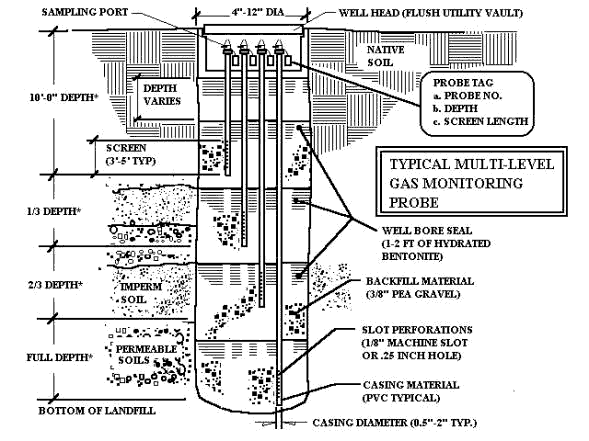
“Landfill Gas Screening Procedures …” from calrecycle.ca.gov and used with no modifications.
Why Landfill Gas Monitoring Saves Lives and Protects Our Environment
- Prevents explosive conditions by detecting methane before it reaches the 5-15% concentration explosive range
- Identifies toxic gas migration that could impact neighbouring communities
- Reduces greenhouse gas emissions through early detection of gas leaks
- Enables proper gas capture for energy generation, turning a hazard into a resource
- Provides essential data for compliance with environmental regulations
- May even protect groundwater resources from contamination through early detection of landfill containment liner penetration
The decomposition process in landfills creates gas under pressure that follows the path of least resistance, often migrating laterally through permeable soil layers unless the landfill has an engineered liner system. This migration can lead to gas accumulation in buildings. In rare cases where particular geological conditions are present, this has occurred hundreds of meters from the landfill boundary, creating invisible death traps if proper monitoring isn't maintained.
While the author of this article only encountered one instance of migration over 100 metres, these sorts of distances are possible.
Early detection through strategic monitoring allows operators to implement controls before dangerous concentrations develop.
Beyond immediate safety concerns, comprehensive monitoring significantly reduces the environmental impact of landfills. Methane, a primary component of landfill gas, has a global warming potential 28-36 times greater than carbon dioxide over a 100-year period.
By identifying and addressing emissions quickly and facilitating remedial actions, monitoring systems play a crucial role in mitigating climate change impacts while simultaneously protecting local air quality.
The economic benefits of thorough monitoring extend beyond avoiding fines and litigation. Modern landfill gas collection systems can convert what was once considered a hazardous waste product into valuable energy, often generating enough electricity to power thousands of homes. These systems rely on monitoring data that goes beyond safety to optimise collection efficiency and maximise energy production potential.
Essential Components of a Landfill Gas Monitoring System
A complete landfill gas monitoring system integrates multiple monitoring points and technologies to create a comprehensive detection network. Each component serves a specific purpose within the overall monitoring strategy, and omitting any element may create dangerous blind spots in the safety system.
Core Components of a Landfill Gas Monitoring System
• Gas collection wells and extraction system
• Perimeter monitoring probes at property boundaries
• Surface emission monitoring points across the landfill cap
• Building protection systems for on-site structures
• Leachate monitoring points (gas dissolved in liquids must not be discharged into sewers)
• Continuous monitoring stations at critical locations
• Data management and reporting system
• Meteorological station for correlating weather effects
The monitoring system's design must account for site-specific factors, including waste composition, local geology, proximity to sensitive receptors, and regulatory requirements.
What works for a small, rural landfill may be woefully inadequate for a large facility near residential areas. Professional assessment by qualified environmental engineers is essential for designing effective monitoring networks.
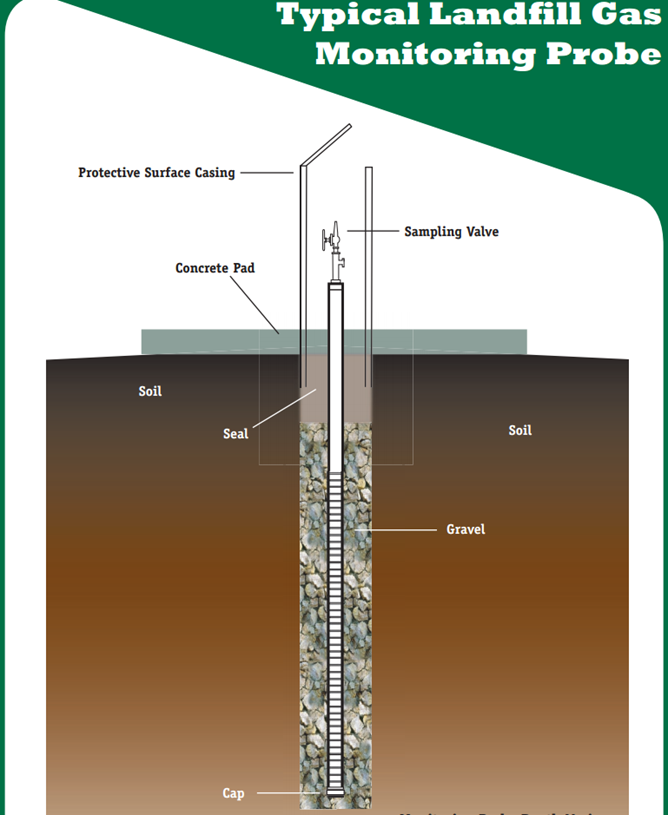
“Landfill Gas Monitoring Systems …” from www.geoengineer.org and used with no modifications.
Gas Collection Wells and Probe Design
Gas collection wells serve dual purposes in modern landfills—controlling gas migration and capturing energy resources. These vertical wells typically penetrate 50-90% of the waste mass depth and feature perforated sections that allow gas to enter while minimising leachate intrusion. The well design must balance gas collection efficiency with structural integrity over decades of settlement and chemical exposure.
Monitoring probes differ from collection wells in that they focus exclusively on measurement rather than extraction. These probes are strategically placed to detect gas migration pathways, often following permeable soil layers or utility corridors where gas movement is most likely. Proper sealing of monitoring probes is critical—a poorly sealed probe creates a preferential pathway for gas migration, potentially contributing to the very problem it's meant to detect.
Materials selection for both wells and probes requires careful consideration of chemical compatibility, temperature resistance, and longevity. While PVC has been common for monitoring probes, high-density polyethylene (HDPE) offers superior resistance to the heat and harsh chemical environment in landfills.
Stainless steel components may be necessary at points experiencing extremely high temperatures from aerobic decomposition or in areas susceptible to vandalism.
Perimeter Monitoring Stations
Perimeter monitoring represents the last line of defence before gas migrates off-site, making these stations critically important for protecting neighbouring properties.
Regulatory requirements typically mandate monitoring probes at regular intervals along property boundaries, with spacing determined by local geology and proximity to structures. These stations must be accessible in all weather conditions and designed to prevent water infiltration that could compromise readings or damage equipment. For more detailed guidance, you can refer to this landfill gas monitoring guide.
Surface Emission Monitoring Points
Surface emission monitoring represents a critical component of comprehensive landfill gas management. These monitoring points create a grid pattern across the landfill cap surface, allowing technicians to identify areas where gas is escaping through the cover material. The EPA typically requires surface scans on a quarterly basis, with measurements taken approximately 4 inches above the surface while walking predetermined paths across the landfill.
The density of monitoring points varies based on site conditions, regulatory requirements, and the age of the waste mass. Newer sections with actively decomposing waste require more intensive monitoring compared to older, stabilised areas. Hot spots identified during initial scans require additional focused monitoring to pinpoint emission sources and evaluate remediation effectiveness. For more detailed procedures, you can refer to this landfill gas monitoring guidance.
When designing a surface monitoring program, weather conditions must be carefully considered. Wind speeds above 5 mph can significantly dilute emissions and create false negative readings, while barometric pressure changes can either suppress or enhance gas emissions. Most regulatory frameworks specify acceptable weather conditions for official compliance monitoring, typically requiring wind speeds below 5 mph and no recent precipitation.
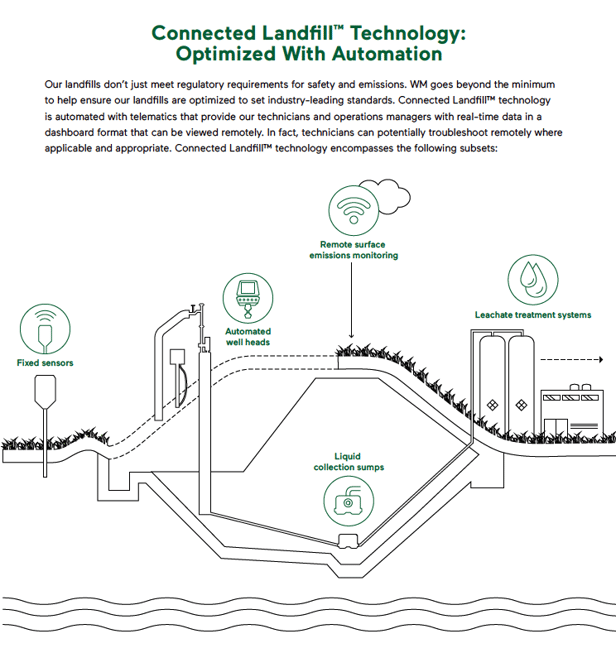
“Automated Landfill Gas Capture Drives …” from locicontrols.com and used with no modifications.
Building and Structure Monitoring Requirements
Any structure within the zone of potential influence from a landfill requires specific monitoring protocols to protect occupants. On-site buildings such as administration offices, maintenance facilities, and gas-to-energy plants face the highest risk and demand continuous monitoring systems with audible and visual alarms. These systems should be calibrated to trigger at levels well below hazardous concentrations, typically at 10-25% of the lower explosive limit (LEL) for methane.
For structures located near but not on landfill property, monitoring requirements depend on distance, geological factors, and building construction. Subslab monitoring systems can detect gas accumulation beneath foundation slabs before it enters the building envelope. These systems may be passive (sampling ports) or active (continuous monitors), depending on the assessed risk level and regulatory requirements.
Utility corridors deserve special attention as they can serve as preferential pathways for gas migration. Manholes, valve boxes, and utility vaults should be incorporated into routine monitoring schedules, with frequency increasing during periods of falling barometric pressure when gas migration typically accelerates. Confined space entry procedures must be strictly followed during these inspections to prevent deadly accidents.
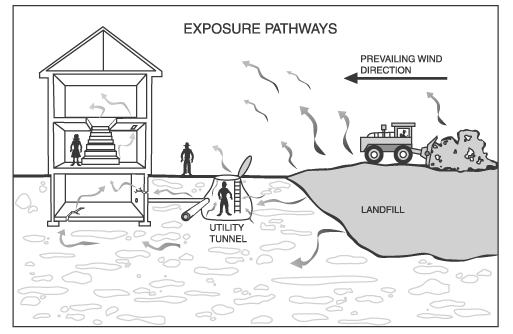
“Landfill Gas Safety and Health …” from www.atsdr.cdc.gov and used with no modifications.
Critical Gases to Monitor at Landfill Sites
While methane often receives the most attention due to its explosion risk, comprehensive landfill gas monitoring must address multiple gases that present various hazards. Each gas requires specific detection methods and has different action thresholds based on its particular dangers.
Methane: The Primary Explosion Hazard
Methane represents the most immediate danger at landfill sites due to its explosive properties when mixed with air at concentrations between 5-15% by volume. This colourless, odourless gas (when pure) is lighter than air, allowing it to travel horizontally and upward through soil and accumulate in enclosed spaces.
Modern monitoring equipment typically detects methane using infrared absorption technology or catalytic bead sensors, with the latter requiring oxygen to function properly.
Regulatory action levels for methane vary by jurisdiction but typically trigger remedial action at 25% of the Lower Explosive Limit (LEL) in structures and 100% LEL at property boundaries.
Continuous monitoring with alarms is usually essential for occupied buildings above gassing landfills, while perimeter monitoring typically occurs on a monthly or quarterly schedule, depending on site classification and historical readings.
Carbon Dioxide: Asphyxiation Risk Assessment
Carbon dioxide concentrations in landfill gas typically range from 30-45% by volume, creating significant asphyxiation risks in confined spaces. As CO₂ is heavier than air, it can accumulate in low-lying areas, displacing oxygen and creating deadly conditions without warning.
Monitoring for carbon dioxide serves two critical purposes: identifying direct health risks and serving as a reliable indicator of landfill gas migration since it moves through soil more consistently than methane.
Action levels for carbon dioxide typically begin at 1.5% by volume in occupied spaces, with regulatory intervention required at higher concentrations. When used as a migration indicator, CO₂ levels above 1.5% in soil gas at property boundaries suggest landfill gas is moving off-site, even if methane remains undetected due to oxidation in the soil profile.
Hydrogen Sulfide and VOCs: Health Impact Monitoring
- Hydrogen sulfide (H₂S) – Detectable by its “rotten egg” odour at low concentrations; toxic at higher levels
- Volatile Organic Compounds (VOCs) – Include benzene, vinyl chloride, and trichloroethylene
- Non-Methane Organic Compounds (NMOCs) – Contribute to smog formation and may include carcinogens
- Mercury vapour – Present in landfills containing fluorescent bulbs and certain electronics
- Siloxanes – Can damage gas collection and energy generation equipment
Health-focused monitoring requires specialised equipment capable of detecting parts-per-billion concentrations of toxic compounds.
Photoionization detectors (PIDs) provide broad-spectrum VOC detection but cannot identify specific compounds. For detailed analysis, gas chromatography/mass spectrometry (GC/MS) sampling offers compound-specific identification and quantification, though typically as periodic rather than continuous monitoring.
When landfills accept industrial waste, monitoring plans must address the specific contaminants associated with those waste streams. Sites with historical disposal of solvents, industrial byproducts, or manufacturing waste require targeted monitoring for compounds specific to those industries, often going beyond standard regulatory requirements to address community concerns and potential liability.
Oxygen and Nitrogen: Indicators of Air Intrusion
While not hazardous themselves, oxygen and nitrogen levels in landfill gas provide crucial information about system performance and potential air intrusion.
In a properly functioning landfill, oxygen levels should remain below 1-2% within the waste mass to maintain anaerobic conditions necessary for proper decomposition and methane generation. Elevated oxygen levels indicate air intrusion, which can create aerobic conditions leading to elevated temperatures, reduced methane production, and potentially dangerous underground fires.
Nitrogen concentrations help distinguish between dilution from atmospheric air versus oxygen consumption through biological activity. The nitrogen-to-oxygen ratio in ambient air remains relatively constant at approximately 3.76:1, so deviations from this ratio in landfill gas samples provide insight into biological activity within the waste mass. This analysis helps operators differentiate between gas collection system issues and changes in decomposition processes.
Monitoring Equipment Selection Guide
Selecting appropriate monitoring equipment represents one of the most consequential decisions in establishing effective landfill gas monitoring procedures. The ideal monitoring system balances accuracy, durability, ease of use, and cost-effectiveness while meeting regulatory requirements and site-specific needs.
Portable Gas Analyzers vs. Fixed Systems
Portable gas analyzers offer flexibility for comprehensive site assessments, allowing technicians to monitor multiple locations with a single device. These instruments typically measure methane, carbon dioxide, oxygen, and hydrogen sulfide simultaneously, with advanced models incorporating GPS tracking to create detailed emission maps. The primary advantage of portable systems lies in their versatility and relatively lower initial cost compared to fixed monitoring networks.
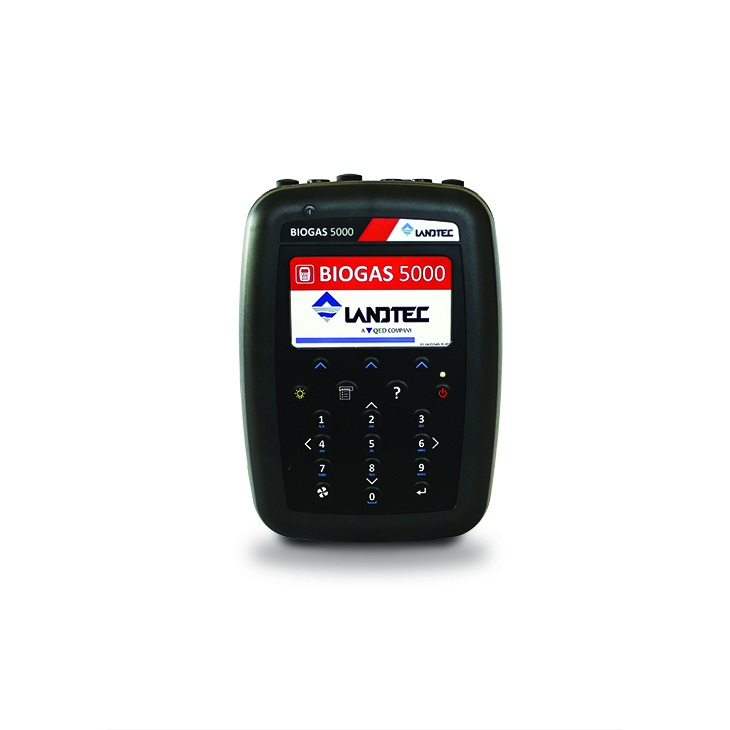
“LANDTEC BIOGAS5000 | QED” from www.qedenv.com and used with no modifications.
Fixed monitoring systems provide continuous surveillance at critical locations, offering real-time alerts when gas concentrations exceed predetermined thresholds. These systems excel in high-risk areas such as buildings, gas collection facilities, and perimeter locations with historical migration issues. While installation costs exceed those of portable equipment, the continuous protection and reduced labour requirements often justify the investment for larger facilities and sensitive locations.
Many landfills implement hybrid approaches, utilising fixed systems at critical points while employing portable analyzers for routine compliance monitoring and surface emission scans. This strategy maximises protection at vulnerable locations while maintaining operational flexibility.
Calibration Requirements and Frequency
Accurate landfill gas monitoring depends entirely on properly calibrated equipment. Even the most sophisticated analyzer will produce misleading results if calibration procedures aren't rigorously followed. Most regulatory frameworks require calibration verification before each monitoring event, with full multi-point calibration performed monthly or according to manufacturer specifications.
Calibration gases must be certified reference standards with documentation traceable to national standards. The concentration of calibration gases should bracket the expected measurement range, typically including a zero point and at least one span gas within the range of regulatory concern. For methane, this often means calibration points at 0%, 2.5% (50% LEL), and 50% by volume to cover both safety and compliance monitoring ranges.
Temperature fluctuations significantly impact calibration stability, particularly for electrochemical sensors used in hydrogen sulfide detection. Best practices include calibrating equipment in similar temperature conditions to those expected during field monitoring or utilising temperature-compensated instruments that automatically adjust readings based on ambient conditions.
Data Logging Capabilities
Modern monitoring programs generate substantial data that requires efficient management systems. Equipment with integrated data logging capabilities automatically records measurements with timestamps and GPS coordinates, eliminating transcription errors and creating defensible compliance records. These systems should allow for customizable sampling intervals, threshold alarms, and export capabilities in formats compatible with regulatory reporting requirements.
Cloud-connected monitoring systems represent the current best practice, transmitting data in real-time to secure servers where it can be accessed by authorised personnel regardless of location. This connectivity enables immediate notification when readings exceed thresholds and facilitates rapid response to developing conditions. For remote or rural facilities, cellular or satellite connectivity options ensure continuous data transmission even in areas with limited infrastructure.
Weather-Resistant Features for Field Use
Landfill environments present harsh conditions, including extreme temperatures, precipitation, dust, and potentially corrosive gases. Monitoring equipment must withstand these challenges while maintaining accuracy and reliability. Key features include IP-rated water and dust protection (minimum IP65 recommended), operating temperature ranges appropriate for local climate extremes, and housing materials resistant to chemical exposure.
Ergonomic considerations significantly impact field efficiency and data quality. Equipment designed for single-handed operation allows technicians to navigate difficult terrain safely while sampling. High-visibility displays readable in direct sunlight, intuitive user interfaces, and extended battery life (minimum 8-10 hours per charge) are essential for effective field deployment.
Cost-Benefit Analysis of Different Equipment Options
| Equipment Type | Initial Cost | Operational Cost | Key Benefits | Limitations |
|---|---|---|---|---|
| Basic portable analyzer | $2,000-$5,000 | Low | Affordable, simple operation | Limited gas range, minimal data management |
| Advanced portable system | $8,000-$15,000 | Medium | Multiple gases, GPS mapping, data logging | Higher maintenance requirements |
| Fixed monitoring network | $20,000-$100,000+ | High | Continuous monitoring, real-time alerts | Significant installation cost, limited coverage area |
| Integrated hybrid system | $30,000-$150,000+ | Medium-High | Comprehensive coverage, centralised data management | Complex implementation, requires dedicated management |
Investment decisions should consider both immediate compliance requirements and long-term risk management goals. While basic equipment may satisfy minimum regulatory standards, more sophisticated systems provide superior protection against liability and offer operational insights that can optimise gas collection efficiency.
For facilities with gas-to-energy systems (EfW), improved monitoring often pays for itself through enhanced energy production and reduced system downtime.
Step-by-Step Monitoring Procedures
Consistent monitoring procedures ensure reliable data collection regardless of who performs the work. A detailed protocol should be documented in the site's monitoring plan and strictly followed during each monitoring event. The following steps outline best practices for comprehensive landfill gas monitoring:
1. Pre-Monitoring Safety Checks
Before initiating any monitoring activities, conduct a thorough safety assessment of the work area and equipment. This includes checking weather conditions (avoiding monitoring during high winds or thunderstorms), verifying personal protective equipment is appropriate and functional, and ensuring communication systems are operational.
For monitoring in confined spaces or potentially hazardous areas, implement specific safety protocols, including attendants, rescue equipment, and atmospheric testing before entry.
Review historical monitoring data to identify locations with previously elevated readings that may require additional safety precautions. Document completion of safety checks in the monitoring log to demonstrate due diligence and establish a defensible record of proper procedure implementation.
2. Equipment Calibration Verification
Verify calibration of all monitoring equipment according to manufacturer specifications and regulatory requirements.
This typically includes zero calibration using certified zero air or nitrogen and span calibration using certified standard gases for each target compound. Record all calibration activities, including gas cylinder serial numbers, certification dates, and calibration results in the monitoring log.
If calibration verification fails, the equipment must be recalibrated or replaced before proceeding with monitoring activities. Never adjust equipment in the field to force readings to match expected values—this compromises data integrity and creates significant liability.
3. Sampling Technique for Subsurface Probes
When monitoring subsurface probes, begin by measuring and recording atmospheric conditions, including barometric pressure, temperature, and precipitation within the previous 24 hours. These factors significantly influence gas migration and must be considered during data interpretation. Remove the probe cap and allow pressure equilibration for 30-60 seconds before connecting sampling equipment.
Draw sample gas at a consistent flow rate (typically 0.5-1.0 litres per minute) to avoid pulling atmospheric air into the probe or creating vacuum conditions that alter gas composition. Allow readings to stabilise before recording final values, typically 1-2 minutes depending on instrument response time and probe depth. Between locations, purge sampling lines with ambient air to prevent cross-contamination between monitoring points.
4. Surface Emission Scan Methods
Surface emission monitoring requires careful attention to technique to ensure valid results. Hold the sampling probe typically approximately 4 inches (10 cm) above the landfill surface while walking at a steady pace of approximately 1-2 feet per second along predetermined paths. These paths typically form a grid pattern with spacing between paths not exceeding 30 meters, though regulatory requirements vary by jurisdiction. For more detailed guidance, you can refer to this landfill gas monitoring guidance.
Record continuous readings using data logging equipment or note elevated readings manually with their corresponding locations. Locations exceeding regulatory thresholds (typically 500 ppm methane for surface emissions) require follow-up monitoring to pinpoint the exact emission source and implement repairs. Flag these locations physically on-site to ensure proper remediation and verification monitoring.

“landfill surface emissions monitoring …” from www.cdrecycler.com and used with no modifications.
5. Documentation and Field Data Recording
Comprehensive documentation forms the foundation of defensible compliance monitoring. Record all relevant information including date, time, technician name, equipment identification numbers, calibration information, and weather conditions. For each monitoring point, document the location identifier, gas concentrations, pressure readings, and any unusual observations such as damaged infrastructure or evidence of disturbance.
Photographic documentation provides valuable context for unusual readings or changing site conditions. Modern monitoring programs often incorporate digital field forms with automatic data validation to flag potential errors or unusual readings for immediate verification, reducing the risk of leaving the site with questionable data that cannot be easily rechecked.
Regulatory Compliance Requirements
Landfill gas monitoring regulations vary significantly by jurisdiction, but most share common elements designed to protect public health and the environment. Understanding these requirements is essential for developing compliant monitoring programs and avoiding potentially severe penalties for non-compliance.
UK Standards for Landfill Gas Monitoring
The UK regulatory framework for landfill gas monitoring is primarily governed by the Environmental Permitting Regulations and guidance from the Environment Agency, with separate guidance for each UK nation. These regulations typically require monitoring of perimeter boreholes, in-waste gas wells, and surface emissions on a schedule determined by the site's permit conditions. Action levels generally include 1% methane and 1.5% carbon dioxide at designated compliance points, with exceedances triggering notification requirements and remedial action.
UK standards emphasise the “Gas Management Plan” approach, requiring operators to develop and implement site-specific monitoring strategies based on conceptual site models and risk assessment. This approach allows for tailored monitoring programs that address the unique characteristics of each facility while maintaining consistent protection standards.
EPA Standards for Landfill Gas Monitoring
In the United States, the Environmental Protection Agency establishes minimum requirements for landfill gas monitoring through the Resource Conservation and Recovery Act (RCRA) and the Clean Air Act. Municipal solid waste landfills must implement gas monitoring programs that detect methane concentrations exceeding 25% of the Lower Explosive Limit (1.25% by volume) in facility structures and the Lower Explosive Limit (5% by volume) at property boundaries. Refer to the EPA Guidance online.
The New Source Performance Standards (NSPS) and Emissions Guidelines require surface emission monitoring for larger landfills, with action levels of 500 parts per million methane at the landfill surface. These regulations also mandate specific monitoring equipment capabilities, monitoring frequencies, and data management practices to ensure consistent implementation nationwide.
State-Specific Monitoring Variations
Many states implement landfill monitoring requirements that exceed federal standards, creating a complex regulatory landscape for facilities operating in multiple jurisdictions. California, for example, requires quarterly surface emission monitoring with more stringent action levels than federal regulations, while Texas implements specific requirements for landfills in areas with karst geology due to increased gas migration potential through underground formations.
When developing monitoring programs for multiple facilities, careful attention to jurisdiction-specific requirements prevents compliance gaps and ensures consistency in implementation. Regular regulatory review should be incorporated into the monitoring program to capture changes in requirements that might affect monitoring procedures or schedules.
Frequency Requirements Based on Site Classification
Typical Monitoring Frequency by Site Classification
• Active MSW Landfills: Monthly perimeter monitoring, quarterly surface scans
• Closed MSW Landfills (<10 years): Quarterly perimeter monitoring, semi-annual surface scans
• Closed MSW Landfills (>10 years): Semi-annual or annual monitoring based on historical results
• Construction & Demolition Landfills: Quarterly to annual monitoring based on waste composition
• Landfills with Gas-to-Energy Systems: Continuous monitoring of collection headers, monthly perimeter
• Sites with Historical Exceedances: Increased frequency until compliance demonstrated for 1+ years
Regulatory agencies may approve modified monitoring schedules based on demonstrated performance and site-specific factors. Facilities with consistent compliance history and effective gas control systems often qualify for reduced monitoring frequency, while sites with recurring exceedances face increased scrutiny and monitoring requirements. Documentation of monitoring history and system performance provides the foundation for negotiating appropriate site-specific monitoring frequencies.
![A landfill collection system shown in 3D cut-away style. By US EPA - LMOP (US EPA - LMOP) [Public domain], via Wikimedia Commons.](https://landfill-gas.com/wp-content/uploads/2018/11/512px-Landfill_gas_collection_system.jpg)
Data Interpretation and Action Levels
Collecting monitoring data represents only half the compliance equation—proper interpretation transforms raw numbers into actionable intelligence. Environmental professionals must understand both the regulatory significance of various gas concentrations and the technical implications for system management and risk control.
Understanding Normal vs. Abnormal Readings
Establishing baseline conditions through consistent monitoring creates the context necessary for identifying abnormal readings that require intervention. Normal landfill gas typically contains 45-60% methane, 40-60% carbon dioxide, <1% oxygen, and trace amounts of hydrogen sulfide and non-methane organic compounds. Significant deviations from established baselines may indicate system failures, changing decomposition conditions, or external factors affecting gas movement.
Trend analysis reveals more meaningful information than individual readings. Gradual increases in methane concentrations at perimeter probes may indicate evolving migration pathways, while sudden spikes often result from barometric pressure drops or water table fluctuations affecting gas movement. Understanding these patterns enables proactive management rather than reactive emergency response.
Methane Action Levels and Response Protocols
Methane action levels trigger specific response requirements based on concentration and location. Typical regulatory thresholds include 25% LEL (1.25% methane) in structures, 100% LEL (5% methane) at property boundaries, and 500 ppm above background for surface emissions. Each threshold requires documented response actions, typically following a tiered approach based on concentration and persistence.
Response protocols should clearly define required actions, responsible parties, notification requirements, and documentation procedures for each action level. Immediate response actions typically include verification monitoring to confirm initial readings, ventilation of affected spaces, notification of appropriate personnel, and implementation of temporary control measures. Persistent exceedances require engineered solutions and regulatory agency involvement to address underlying causes.
Trend Analysis Techniques
Sophisticated data analysis reveals patterns not apparent in individual readings. Statistical techniques such as control charts, regression analysis, and correlation with external factors (barometric pressure, precipitation, temperature) identify subtle changes in system performance before they develop into compliance issues. Geographic information systems (GIS) enable spatial analysis of monitoring data, revealing migration patterns and system coverage gaps.
Modern data management systems automate much of this analysis, generating alerts when statistical anomalies appear or when trends suggest future exceedances are likely. These predictive capabilities transform monitoring from a reactive compliance activity into a proactive management tool that prevents problems rather than merely documenting them.
Common Monitoring Challenges and Solutions
Even well-designed monitoring programs encounter challenges that can compromise data quality or operational efficiency. Recognizing these common issues and implementing proven solutions ensures reliable monitoring results under all conditions.
Weather Effects on Monitoring Results
| Weather Condition | Effect on Monitoring | Solution |
|---|---|---|
| Falling barometric pressure | Increased gas migration and surface emissions | Schedule critical monitoring during falling pressure events |
| Frozen ground conditions | Reduced natural venting, increased lateral migration | Increase perimeter monitoring frequency during freeze periods |
| Heavy precipitation | Water-saturated cover restricting normal gas flow | Temporarily increase vacuum on gas collection system |
| High winds (>5 mph) | Dilution of surface emissions, unreliable readings | Reschedule surface monitoring for calm conditions |
| Extreme heat | Instrument drift, reduced battery life | Shade instruments, increase calibration frequency |
Meteorological monitoring provides essential context for interpreting gas data. Installing a weather station at the landfill allows correlation between atmospheric conditions and gas behaviour, enabling operators to distinguish between weather-related fluctuations and actual system issues.
Many regulatory frameworks specifically address weather effects by establishing monitoring conditions (e.g., no surface monitoring during precipitation or high winds) or requiring barometric pressure recording alongside gas measurements.
Seasonal variations require adaptive monitoring approaches. Winter conditions often increase gas migration potential due to frozen cover systems limiting vertical venting, while summer heat can accelerate biological activity and gas generation rates. Monitoring schedules should account for these seasonal effects, with increased frequency during high-risk periods and at critical locations most affected by seasonal changes.
Equipment Malfunction Troubleshooting
Field technicians should be trained to recognise common equipment issues, including sensor poisoning from exposure to high gas concentrations, water intrusion affecting electrochemical sensors, filter clogging from dust or moisture, pump failure reducing sample flow, and battery issues causing erratic readings or instrument shutdown.
A field troubleshooting guide with decision trees helps technicians determine whether monitoring can continue with modified procedures or must be rescheduled after equipment repair.
Access Issues at Difficult Monitoring Points
Physical access challenges include overgrown vegetation, erosion and landfill settlement around monitoring points, flooded conditions, and damaged infrastructure.
Maintenance programs should include regular clearing of access paths, protective measures for monitoring points in areas subject to erosion or flooding, and inspection of monitoring point integrity during each visit. For more detailed guidance, you can refer to US EPA landfill gas monitoring guidance and other local regulator publications.
Some monitoring locations present particular safety challenges, including steep slopes, confined spaces, or areas with wildlife hazards. These locations require specific access protocols, including appropriate personal protective equipment, communication procedures, and possibly multiple personnel.
When redesigning monitoring networks, consider relocating problematic points to more accessible locations that provide equivalent data without compromising safety or regulatory compliance.
Building Your Monitoring Schedule and Maintenance Plan
A comprehensive monitoring schedule integrates regulatory requirements, site-specific risk factors, operational constraints, and resource availability to create an efficient, compliant program. This schedule should be documented in the site's gas management plan and reviewed regularly to incorporate changing conditions or requirements.
Creating an Annual Monitoring Calendar
Develop a calendar that clearly identifies all required monitoring activities, responsible parties, equipment requirements, and reporting deadlines. This calendar should account for seasonal factors affecting both gas behaviour and site access, scheduling critical monitoring during optimal conditions while maintaining minimum regulatory frequencies. For more detailed information, you can refer to the landfill gas monitoring guidance provided by your location's environmental regulator.
Equipment Maintenance Schedules
Preventive maintenance significantly reduces monitoring disruptions and data quality issues. Establish maintenance schedules based on manufacturer recommendations, usage patterns, and field experience, typically including monthly sensor replacement or reconditioning, quarterly calibration verification against certified standards, and annual factory servicing for sophisticated instruments.
Maintain detailed maintenance logs documenting all service activities, parts replacements, and calibration adjustments to demonstrate proper equipment management during regulatory inspections or legal proceedings.
Staff Training Requirements
Effective monitoring depends on properly trained personnel who understand both procedural requirements and the underlying science of landfill gas behaviour. Training programs should cover equipment operation, calibration procedures, sampling techniques, troubleshooting, data management, safety protocols, and regulatory requirements.
Regular refresher training and competency verification ensure consistent implementation regardless of personnel changes or infrequently performed monitoring tasks.
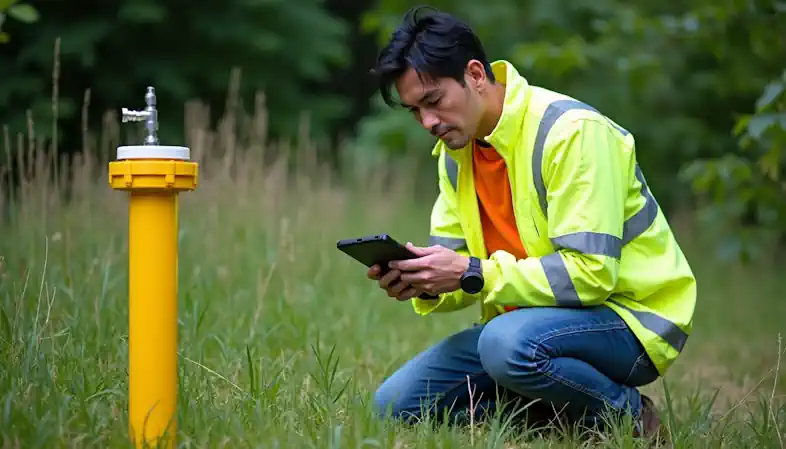
Taking Action When Gas Levels Exceed Limits
Exceedances require prompt, documented response following predetermined protocols established in the gas management plan. These protocols should provide clear guidance while allowing sufficient flexibility to address site-specific conditions and evolving situations. Every exceedance, regardless of magnitude, requires thorough documentation of both the condition and the response actions implemented.
Emergency Response Procedures
When monitoring reveals potentially dangerous conditions—particularly methane concentrations approaching explosive levels in structures or hydrogen sulfide levels exceeding health-based thresholds—immediate action is required to protect life safety. Emergency procedures should include evacuation protocols, ventilation methods, isolation of ignition sources, notification of emergency services, and establishment of safety perimeters around affected areas. These procedures must be regularly practised through drills and reviewed after any actual implementation to identify improvement opportunities. For detailed guidance on monitoring, refer to the landfill gas monitoring guidance.
Regulatory Notification Requirements
Exceedances typically trigger notification requirements to regulatory agencies within specific timeframes—often 24-72 hours for significant exceedances, with written follow-up reports detailing the exceedance, response actions, and corrective measures. Maintaining current contact information for all relevant regulatory personnel ensures timely notifications during both business and non-business hours.
Documentation systems should include notification templates, contact logs, and confirmation records to demonstrate compliance with reporting requirements.
Remediation Options and Implementation
Long-term remediation strategies address the root causes of gas exceedances rather than merely responding to symptoms. These strategies may include expanding the gas collection system, increasing extraction rates in affected areas, installing passive venting systems, implementing barrier technologies, or modifying operational practices that contribute to gas migration.
Engineering solutions should be designed by qualified professionals with landfill gas experience and implemented under appropriate permits and regulatory oversight.

Frequently Asked Questions
Landfill operators, environmental professionals, and community stakeholders frequently ask similar questions about gas monitoring programs. Addressing these common questions helps build understanding and support for comprehensive monitoring efforts while clarifying technical and regulatory aspects of gas management.
The following FAQs address the most common inquiries received by regulatory agencies and landfill operators regarding monitoring programs, with answers reflecting current best practices and regulatory expectations.
How often should landfill gas monitoring be performed?
Monitoring frequency depends on regulatory requirements, site classification, historical compliance, and risk factors. At a minimum, most active municipal solid waste landfills require monthly perimeter monitoring and quarterly surface emission monitoring, while closed sites may qualify for quarterly or semi-annual schedules based on demonstrated stability.
Critical locations with historical exceedances or sensitive receptors typically require more frequent monitoring regardless of the overall site schedule. Continuous monitoring systems provide the highest level of protection at critical locations such as on-site buildings, gas collection facilities, and perimeter points near occupied structures.
For more detailed guidelines, you must refer to the landfill gas monitoring guidance provided by your local regulatory body.
- Perimeter probe monitoring: Monthly to quarterly
- Surface emission scans: Quarterly to annually
- In-building monitoring: Continuous to monthly
- Collection system monitoring: Weekly to monthly
- Leachate collection system: Monthly to quarterly
- Special monitoring during changing barometric pressure: As needed
Custom monitoring schedules based on site-specific conditions often provide more meaningful data than rigid calendar-based approaches.
Working with regulatory agencies to develop appropriate site-specific schedules demonstrates commitment to protection while optimising monitoring resources.
What are the most dangerous gases produced in landfills?
Methane presents the most immediate danger due to its explosive properties when mixed with air at 5-15% concentration. Carbon dioxide creates asphyxiation risks in confined spaces by displacing oxygen.
Hydrogen sulfide, even at low concentrations (10-50 ppm), causes respiratory irritation, eye damage, and neurological effects, while high concentrations (>500 ppm) can cause rapid loss of consciousness and death.
Volatile organic compounds, though present in lower concentrations, may include carcinogens such as benzene, vinyl chloride, and trichloroethylene that present long-term health risks through chronic exposure.
Can landfill gas travel through soil into nearby buildings?
Landfill gas can migrate hundreds of metres through permeable soil layers, but such large distances through geological soils are rare. However, utility corridors and geological features such as fractured bedrock or karst formations can more easily involve those distances.
This LFG migration creates risk for structures located near landfills, particularly buildings with basements or slab foundations that can trap gases migrating from below. Detection systems, including subslab monitoring points, foundation vents, and perimeter probes, help identify migration before it reaches dangerous levels.
Building protection systems may include passive barriers (geomembranes, low-permeability clays), passive venting systems that provide preferential pathways away from structures, or active systems that use mechanical ventilation to maintain negative pressure beneath foundations. These systems require regular monitoring and maintenance to ensure continued effectiveness, particularly in areas with demonstrated gas migration.
What qualifications are needed to perform landfill gas monitoring?
Recommended Qualifications for Monitoring Personnel
• Understanding of landfill gas composition, behavior, and hazards
• Training in equipment operation, calibration, and maintenance
• Knowledge of relevant regulatory requirements and action levels
• Certification in confined space entry (where applicable)
• Health and safety training including hazard recognition
• Documentation and reporting skills
• Basic troubleshooting capabilities for field equipment
• Physical capability to access monitoring locations safely
While specific certification requirements vary by jurisdiction, most regulatory frameworks require demonstration of competence through training records, supervised experience, and documentation of procedures. Some jurisdictions require professional oversight by licensed engineers or certified environmental professionals, particularly for compliance monitoring and system design.
Beyond formal qualifications, effective monitoring requires attention to detail, critical thinking skills, and sound judgment when encountering unusual conditions or equipment issues. Technicians must understand not just the procedural aspects of monitoring but the underlying purpose and significance of the data they collect.
Regular performance audits, including field observation of monitoring techniques and data review, help ensure monitoring quality regardless of formal qualifications. These audits identify training needs, procedure improvements, and equipment issues before they affect compliance status.
How long must monitoring continue after a landfill closes?
Post-closure monitoring typically continues for a minimum of 30 years under current regulations, though the actual duration depends on site-specific factors including gas generation rates, historical compliance, and proximity to sensitive receptors. Many jurisdictions implement performance-based approaches that require continued monitoring until specific stability criteria are met rather than arbitrary timeframes.
Significant gas generation can continue for 50+ years after waste placement, with peak production typically occurring 5-10 years after placement before very gradually declining.
Sites with high organic content, wet conditions, or certain industrial wastes may generate significant gas volumes for extended periods beyond typical projections. Regular reassessment of generation potential using both modelling and field measurements helps establish appropriate monitoring duration.
[Published Nov 24, 2012. Completely re-written and updated August 2025.]
Best Portable Landfill Gas Analyzer Reviews & Comparison
Landfill gas monitoring is critical for health, safety, and compliance. A top-notch portable analyzer detects harmful gases in real-time, safeguarding workers and the environment. As regulations tighten, reliable equipment becomes essential for avoiding fines and mitigating risks associated with gas emissions from decomposing waste…
Why Do Landfill Gas Monitoring in Soil, the Air, Near the Surface, & In Confined Spaces
Landfill gas monitoring is critical for preventing health risks and hazards near landfill sites. Detecting gases like methane, which is flammable and a climate change contributor, is essential. Effective monitoring employs soil, air, and emissions techniques to ensure safety and environmental protection…
Landfill Gas Monitoring Equipment
The choice of landfill gas monitoring equipment for modern landfills is wider than ever before. Types of Landfill Gas Monitoring Equipment Wikipedia provides a detailed explanation of the different types of landfill, gas monitoring, each of which demands it's own equipment to perform: Surface Monitoring For surface monitoring, a monitor may be either: Single reading […]
Testing Methods for Landfill Gas Migration Control
The investigation of the extent and source of landfill gas migration, is the first step in landfill gas migration control, and may need to take the path which follows: to identify the source of the gas; to identify the migration pathway; to understand the mechanisms causing the migration; This is essential for the engineers and technicians […]




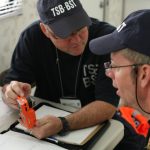
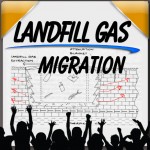

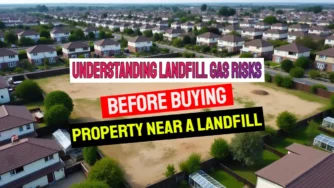

Hi. I see that you provide some valuable gas monitoring info. Do you know that we’ve created a full line of gas monitoring equipment that alerts you when harmful vapours like carbon monoxide, ammonia, nitrogen dioxide and chlorine are present.
Tell me how you start to write a Landfill Gas Monitoring Procedure. How do you decide where the landfill gas monitoring boreholes are placed around the landfill?